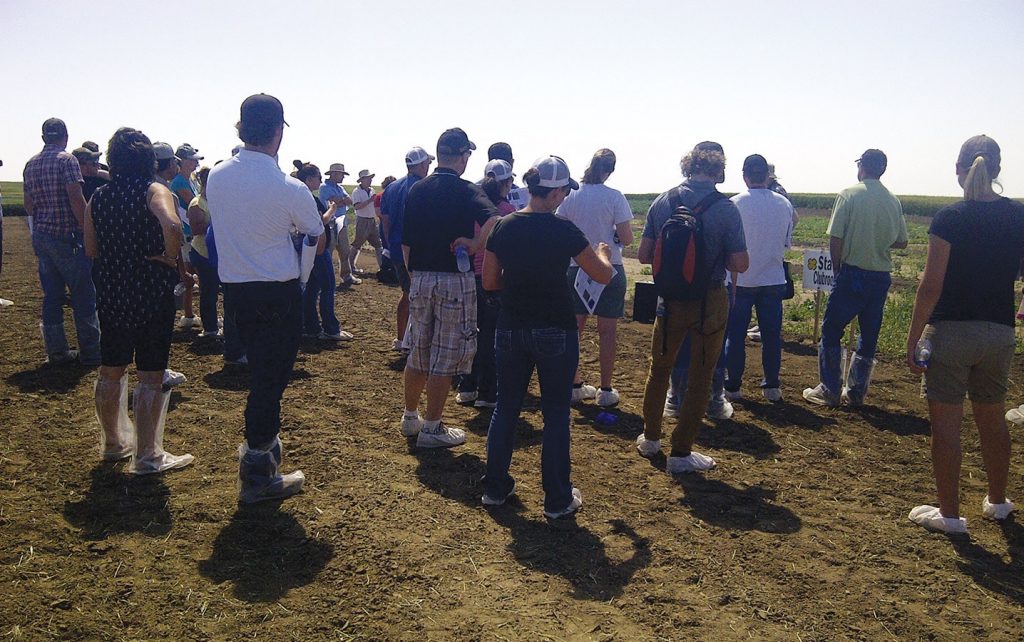Key Result
The maintenance of a naturally-occurring clubroot nursery provided an evaluation site for over 60 canola lines, varieties and cultivars over four years. The nursery site was also used extensively for training and extension activities.
Project Summary
When you get served lemons, make lemonade. In 2007, an irrigated canola crop west of Brooks, Alberta was discovered to have a severe infestation of clubroot caused by Plasmodiophora brassicae. From 2008 to 2016 the infested field provided an opportunity for clubroot research, extension and training in southern Alberta.
The primary goal of this project was to maintain a clubroot nursery in southern Alberta to allow the consistent testing, and continued development, of clubroot-resistant canola varieties. The site was a naturally-occurring clubroot disease nursery in southern Alberta where hybrid canola seed companies could screen for clubroot resistance to Williams pathotype 5, which is predominant in that field. The pathotype 5 and sandy brown soil with neutral to alkaline pH provided a testing site unlike any other in Canada.
Maintenance of the site and screening of clubroot resistance for hybrid canola seed companies resulted in:
- In 2013 there were two of four lines evaluated showed significant resistance to clubroot pathotype 5.
- In 2014 there were 20 of 21 lines with resistance to clubroot pathotype 5.
- In 2015 there were four of 21 lines with resistance to clubroot and 10 with intermediate resistance.
- In 2016 there were no lines with resistance and one out of 11 with intermediate resistance to clubroot pathotype 5.
As part of this project, a clubroot surveillance program sampled approximately 900 fields between 2013 and 2016 in southern Alberta. The survey provided early detection of new outbreaks and allowed proactive management responses. The survey has also helped identify fields with new virulent pathotypes of clubroot.
The comprehensive clubroot surveillance and early detection in southern Alberta found the following:
- In 2013 no new clubroot-infested fields found in any of the 220 fields assessed.
- In 2014 no new clubroot-infested fields discovered in any of the 210 fields assessed.
- In 2015 there were no new clubroot-infested fields discovered in any of the 300 fields visited, however, a confirmed field in Mountain View County was reported by the local Agricultural Service Board Fieldman. Additionally, a new pathotype that was virulent on clubroot-resistant canola cultivars was discovered at a naturally-infested field in the County of Newell.
- In 2016 there was a second field in Mountain View County reported.
The clubroot nursery site has also been a valuable staging point for demonstration plots used in extension and training activities. These activities have improved the awareness of, and scouting for, clubroot in southern Alberta.
Publications that were produced from this research include:
- Howard, R. J., D. A. Burke, S. E. Strelkov, D. C. Rennie, C. A. Pugh, S. L. I. Lisowski, M. W. Harding, and G. C. Daniels. (2014). Evaluation of methods for cleaning and disinfesting equipment contaminated with clubroot. Can. J. Plant Pathol. 36(2): 266-266. (Abstract) from the Annual Meeting, 2013/Réunion annuelle, 2013 The Canadian Phytopathological Society, Canadian Journal of Plant Pathology, 36:2, 252-279, DOI: 10.1080/07060661.2014.921425
- S.E. Strelkov, V.P. Manolii, M.W. Harding, S.F. Hwang, E. Manolii, K. Zuzak, D.C. Rennie, J. Feng, M. Raham, G.C. Daniels, D.A. Burke, T.B. Hill, K. Zhar and D. Feindel. 2017. Occurrence and spread of clubroot on canola in Alberta in 2016. Canadian Plant Disease Survey, 97: 164-167. Available online (January 2022).






